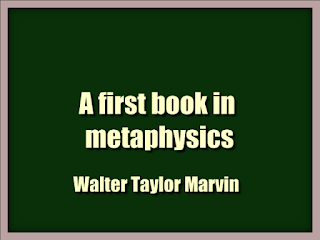A first book in metaphysics by Walter Taylor Marvin
The Author endeavoured in this book to give a practical philosophy course to the student of philosophy or the general reader
his book is planned to be a student's first book in philosophy, though the course which it outlines may either precede or follow a course in the history of philosophy. In writing the book I have had in mind to fulfil the following three purposes:
First, I wished the book to be simple, clear and definite, and as brief as possible in order that the student using it might devote by far the larger part of his time to further reading. That is, the book should form a system of closely connected topics, an outline to be filled in by extensive outside reading and an outline to keep this reading from becoming hopelessly confusing.
This reading should be selected from current philosophical literature and especially from those philosophical classics which are intelligible to the beginner. Secondly, I wished to write, not an outline of the historical development of the problems of metaphysics, nor a long discussion regarding the definition and division of philosophy, nor again an account of rival philosophical schools and their theories, but a book in metaphysics, a book representing consistently one contemporary philosophical tendency. This forced the book to be partisan, but I believe that the beginner demands, and has the right to demand, a modern philosophical creed.
Later he may have to outgrow this creed, but in the meantime, he insists upon being partisan and takes little interest in being led through a philosophical museum. Accordingly, following my own philosophical convictions,
I have tried to formulate briefly and rigorously that type of neo-realism which is a return at least to the spirit, though not always to the letter, of Plato and of Aristotle.
Lastly, I wished to adapt the book especially to the Oxford or preceptorial method of instruction. Accord- ing to this method, the textbook and the lectures in class should serve to give a general view of the subject but should play a far less important part than the student's independent reading and study.
The results of this reading and study should be expressed in a weekly, or better fortnightly, essay submitted to the preceptor and afterwards discussed with him in an informal conference held preferably in his private study and attended by not more than three or four students. This enables the teacher to deal with his students as individuals and to vary greatly the amount and kind of reading he as- signs to ^ach. Some will do not only more difficult reading than others but three or four times the amount of reading.


